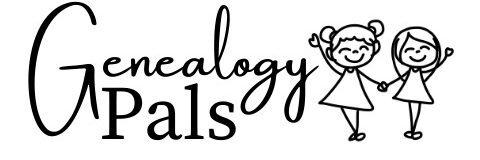As a self-proclaimed word nerd and genealogist, I began to wonder if there was a difference between the terms genealogy and ancestry. What do they each mean? How are they different? And does it even matter?
Genealogy vs Ancestry: Ancestry is the line of people who come before you in your family line (forefathers or progenitors like parents, grandparents, et al). Genealogy is the study of one’s family line or ancestry. These terms are subtly but vitally different and important.
Ready to make sure you’ve got these two terms down pat? Keep reading, friend!

Genealogy and Ancestry: the Definitions and Differences
Let’s start by looking at definitions, etymology (origins of words), and differences between both terms. And because we’re looking back at how these terms are different, let’s pull definitions for both terms from several dictionaries – the 1828 Webster’s dictionary and a modern Google search (using the Oxford dictionary). We’ll also look at the etymology as pulled from those dictionaries and online sources.
Ancestry (noun) – from the Old French word “ancestre” for ancestors and forefathers (or “ancesserie” and “auncestrie”, depending on the etymology source) as adopted into Middle English.
- Google Search and Oxford Dictionary: 1. one’s family, lineage, or ethnic descent; 2. the origin or background of something.
- Webster’s 1828 dictionary: a series of ancestors or progenitors, lineage, or those who compose the line of natural descent.
Genealogy (noun) – from the Greek words “genea” (race, generation) and “logia” (oracles or communications of divine origin, plural of “logion”). However, “logia” has been turned into an English suffix “-ology”. Adding “ology” to the end of a word indicates “the study of” whatever preceded the suffix element.
- Google Search and Oxford Dictionary: a line of descent traced continuously from an ancestor.
- Webster’s 1828 dictionary: an account or history of the descent of a person or family from an ancestor, enumeration of ancestors and their children in the natural order of succession, pedigree, lineage
So let’s compare these definitions and their definitions by simplifying things down to a single sentence again.
Ancestry is the people that you descend from (your parents, grandparents, etc.) while genealogy is the study of finding out who those people are – and then documenting their lives and their family relationships.
In other words, ancestry is your family line just as your ancestors are the people in your family line who were born before you. Genealogy is the study of your family line and all of those people in your ancestry.
What is Genealogical Ancestry?
Genealogical ancestry is the study of those ancestors who came before you and then figuring out where those ancestors fit on your family tree in relation to you. It’s your pedigree chart, in essence.
Based on your genealogical ancestry and pedigree chart, you can see every person who went before you and contributed to your existence.
Here’s a fun fact, though: you actually have two family trees! That’s right: every person actually has two family trees: a genealogical ancestry (or genealogical tree) and your genetic ancestry (or genetic tree). So now let’s take a brief look at genetic ancestry.
What is Genetic Ancestry?
Genetic ancestry is the study of those ancestors who passed along their DNA to you over the generations. Because of how DNA is inherited, your genetic tree (or genetic ancestry) can look very different than your genealogical ancestry.
This is an involved study and topic, so it’ll warrant extra articles. But here’s the short version.
In an ideal situation, two parents would each contribute half of their DNA (50%) to a child. Each grandparent would pass along 25% of their DNA to a grandchild, and a great-grandparent would only pass along 12.5% of their DNA, and so on (with that percentage dropping by half with each generation).
However, that’s in an ideal situation and real life is rarely ideal. So in actuality, one parent may give you 55% of their DNA and the other parent would only be the source of the other 45% of your DNA. Then, as the DNA merges and mixes, it can create new strands that don’t match either parent.
Thus, the further back you go in time, there’s less and less chance of you having inherited any DNA from an ancestor (source). In other words, there will be people in your genealogical ancestry with whom you don’t share any genetic ancestry (there’s no shared DNA between the two of you).
Thus, your genetic ancestry may look different than your genealogical ancestry – even though you’re all related. It’s crazy in a nerdy, genealogy-is-cool kind of way.
How to Track Ancestry and Genealogy
Because there are several types of ancestry (genetic, genealogical) and multiple ways to track each kind, it can get overwhelming. So let’s narrow things down to the three most commonly used, general methods of tracking your ancestry and genealogy.
The three most commonly used ways to track ancestry and/or genealogy are:
- Talking to living family members and relatives.
- Following a paper trail (in this case, a paper trail can mean actual paper, microfilm, or a digitized paper trail that is available online).
- Having your DNA tested.
There are pros and cons to each method – so let’s talk about each one.
| Method | Pros | Cons |
|---|---|---|
| Talking to living family members and relatives | 1. First-hand accounts are preferable to poring over old books and record collections because of the in-person connection and ease of availability. 2. You get to talk to the self-appointed “family historian” and learn a lot of really cool facts. | 1. If there isn’t a self-appointed “family historian,” then there’s nobody to talk to. 2. Oh, and you’re the new family historian, so congratulations (okay, so in our minds, this is actually a pro, not a con!) |
| Following a paper trail | Free online resources (like FamilySearch.org) make it easy to help you get started on even finding your paper trail’s starting place. | Due to privacy laws, most records can only be released to the public after several decades. This makes it harder to track more recent relatives in public records like censuses. |
| Having your DNA tested | Find out your DNA and how it matches to others on the database – helping you find living relatives to talk to and their existing genealogical findings. | It costs money to take the test and results take several weeks or longer, depending on the test. The results you get will also depend on the sample size of the DNA database. |
Let’s talk some more about our first option of talking to a living family member or self-appointed family historian. Here are a few tips and notes on what you need to do:
- Call the oldest member of your family (that you have contact with) and start asking questions.
- Be prepared with specific questions you’d like to ask. Calling and saying, “Tell me what you know about the family,” can be overwhelming and confusing.
- Once you get a family member talking to you it won’t take much to keep the ball rolling.
For the second option (following a paper trail), here are some tips and notes to help you get going:
- Start with free resources, especially FamilySearch.org.
- FamilySearch.org offers a shared tree, giving you a great starting place that can help you bridge a lot of gaps.
- Every person leaves a paper trail of all sorts of different documents (birth, marriage, death, military, land, etc.). Get creative in your searches.
- Start backward with your ancestor’s life – first find death and burial records or the latest census record they’re noted in. Then, work backward in time and follow the paper trail to find their vital records.
For the final option of getting your DNA tested, here are some tips to help you get started after your results are back:
- Check all of the companies that offer DNA and genealogical testing. They all have different offerings, database sizes, and options.
- Some of the big-name DNA kits are offered for sale by 3rd party sellers, so look at those, too. Here are three of the best available on Amazon: the AncestryDNA kit, the 23andMe Health and Ancestry DNA kit, and the MyHeritage DNA test kit.
- Once your DNA has been matched, look at the estimated relations. Then, reach out to people who are closely related to you.
- Share research and information you do have with those relatives and collaborate to piece together even more parts of your shared family tree.
Ideally, it’s best to use several methods to track your genealogy and ancestry. In fact, I’m a huge fan of using all three options (as is Breanne).
I’m so glad I talked to my grandparents (when they were still alive) to get the stories that I did. I wish I’d gotten more! These days, I have to rely on paper trails and DNA results to connect with older relatives to gather more evidence, stories, and research. But that’s okay – because I’m tracking my genealogy the best I can.
So get out there and track yours in the best way you can, too.
Related Questions
What is the difference between genealogy and family history? Genealogy is the study of historical facts related to families, ancestry, and culture while family history is sometimes referred to as “putting meat on the bones” – it’s the stories and human experiences of history.
What is the difference between genealogy and genealogy? Genealogy is the study and preservation of family history, ancestry, and culture. Genealogy is a super common misspelling of genealogy. We make this mistake sometimes, too, so don’t feel too badly.
What are the best genealogy websites? The top four genealogy websites are Ancestry.com, FamilySearch.org, FindMyPast.com, and MyHeritage.com. The best overall website is Ancestry.com but FamilySearch is a solid free option. Read our analysis (and how to get all 4 for free) by clicking here.
